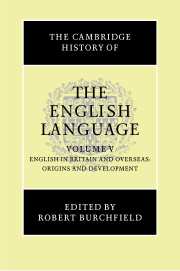Book contents
- Frontmatter
- 1 Introduction
- PART I Regional varieties of English in Great Britain and Ireland
- 2 ENGLISH IN SCOTLAND
- 3 ENGLISH IN WALES
- 4 ENGLISH IN IRELAND
- 5 THE DIALECTS OF ENGLAND SINCE 1776
- PART II English overseas
- Glossary of linguistic terms
- Bibliography
- Index
- THE CAMBRIDGE HISTORY OF THE ENGLISH LANGUAGE
- Map 7.1 Movements of English/Creole speakers in the seventeenth century
- Map 7.2 Movements of English/Creole speakers after 1700
- References
2 - ENGLISH IN SCOTLAND
from PART I - Regional varieties of English in Great Britain and Ireland
Published online by Cambridge University Press: 28 March 2008
- Frontmatter
- 1 Introduction
- PART I Regional varieties of English in Great Britain and Ireland
- 2 ENGLISH IN SCOTLAND
- 3 ENGLISH IN WALES
- 4 ENGLISH IN IRELAND
- 5 THE DIALECTS OF ENGLAND SINCE 1776
- PART II English overseas
- Glossary of linguistic terms
- Bibliography
- Index
- THE CAMBRIDGE HISTORY OF THE ENGLISH LANGUAGE
- Map 7.1 Movements of English/Creole speakers in the seventeenth century
- Map 7.2 Movements of English/Creole speakers after 1700
- References
Summary
Introduction
Insular West Germanic speech was first established in what is now Scotland in the sixth century. Two phases are clearly identifiable in its history: the first includes the emergence of a distinctively Scottish form, developing independently of the Northern dialect of England though like it derived from Northumbrian Old English, and its attainment to the rank of official language in an autonomous nation—state; and the second, the gradual adoption in Scotland of a written, and subsequently also a spoken, form approximating to those of the English metropolis, with consequent loss of status of the previously existing Scottish tongue. In the course of the linguistic history of Scotland, that is, first one and then two speech forms, both descended from Old English, have been used within the national boundaries. For convenience we will choose to designate the first Scots and the second Scottish English. This situation has no exact parallel in the English-speaking world.
Uniquely among Old English-derived speech forms other than standard literary English, Scots has a claim to be regarded as a distinct language rather than a dialect, or latterly a group of dialects, of English. This claim has been, and continues to be, the subject of serious, reasoned and at times heated debate, at both popular and scholarly level (see Aitken 1981a and McClure 1988: 17–31 for contributions from opposing viewpoints): a debate which embraces historical, political, social and literary as well as linguistic issues and has important implications in the field of education.
Keywords
- Type
- Chapter
- Information
- The Cambridge History of the English Language , pp. 21 - 93Publisher: Cambridge University PressPrint publication year: 1994
References
- 21
- Cited by



